Welcome to Long Beach, where you’ll find an abundance of birds! Long Beach has various bird species, from tiny wrens and sparrows to large raptors like hawks and ospreys.
Long Beach provides a perfect habitat for various birds with its rich wetlands, estuaries, and oceanfront coastline. From spring to fall, the skies of Long Beach are full of waterfowl, shorebirds, and songbirds.
Birdwatchers will have many opportunities to observe various species in their natural habitats. Whether you’re just starting or have been birdwatching for years, Long Beach is a great place to explore and appreciate the wonderful world of birds.
24 Birds to Watch in Long Beach
Long Beach is a city in Southern California that offers a variety of habitats for birds, from sandy beaches and wetlands to urban parks and gardens. Whether you are a beginner or an expert birder, you can find many species of birds to watch and enjoy in Long Beach.
Here are 24 birds that you should look out for in Long Beach
1. Piping plover
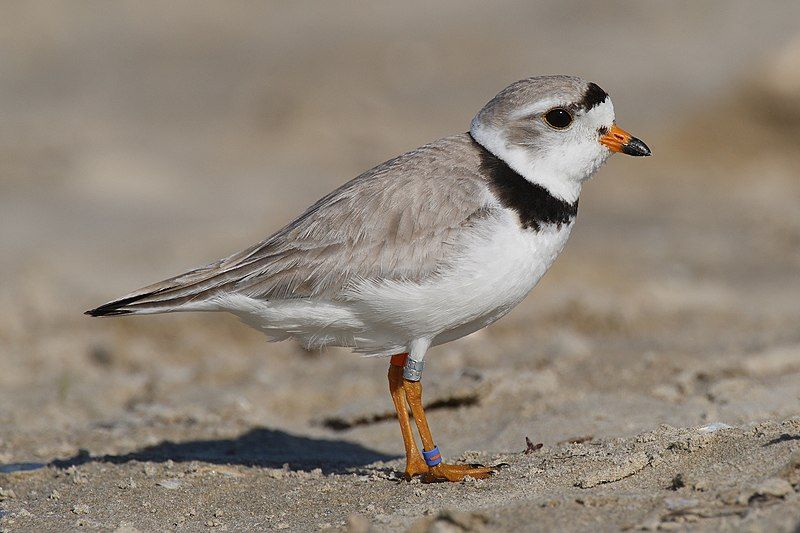
The piping plover is a small shorebird native to North America. It has a sand-colored plumage, resembling that of a sparrow, and is typically found inhabiting coastal sand and gravel beaches.
It is easily recognizable due to its yellow-orange-red legs, a distinctive black band across its forehead from eye to eye, and a black stripe running along the breast line.
The piping plover is a ground-nesting species, meaning it builds its nests directly on the sand or gravel beach. It feeds mainly on insects, small crustaceans, and other invertebrates living in the sand.
As a result of their dependence on these beach habitats, piping plovers are highly vulnerable to human activities such as beach development, recreational activities, and hunting. Therefore, conservation efforts are underway to protect this species and its habitats.
| Kingdom | Animalia |
| Phylum | Chordata |
| Class | Aves |
| Order | Charadriiformes |
| Family | Charadriidae |
| Genus | Charadrius |
| Species | C. melodus |
2. Great Blue Heron
The great blue heron is a majestic bird found throughout North and Central America, South America, the Caribbean, and the Galápagos Islands. It belongs to the Ardeidae family and is the most prominent member of the heron family.
This majestic bird can be found near the shores of open water and in wetlands, which are essential habitats for the species. Its long, slender neck and long, pointed beak make it easy to identify amongst other herons.
The great blue heron stands in the shallow waters of lakes, rivers, and streams, waiting for its prey to swim by. Its long legs make it an excellent water, allowing it to move quickly and stealthily through the water.
With its large wingspan, the great blue heron is capable of impressive flight, soaring gracefully through the skies. The beauty of this species is undeniable, and it is a sight to behold in its natural habitat.
| Kingdom | Animalia |
| Phylum | Chordata |
| Class | Aves |
| Order | Pelecaniformes |
| Family | Ardeidae |
| Genus | Ardea |
| Species | A. herodias |
3. Brown Pelican
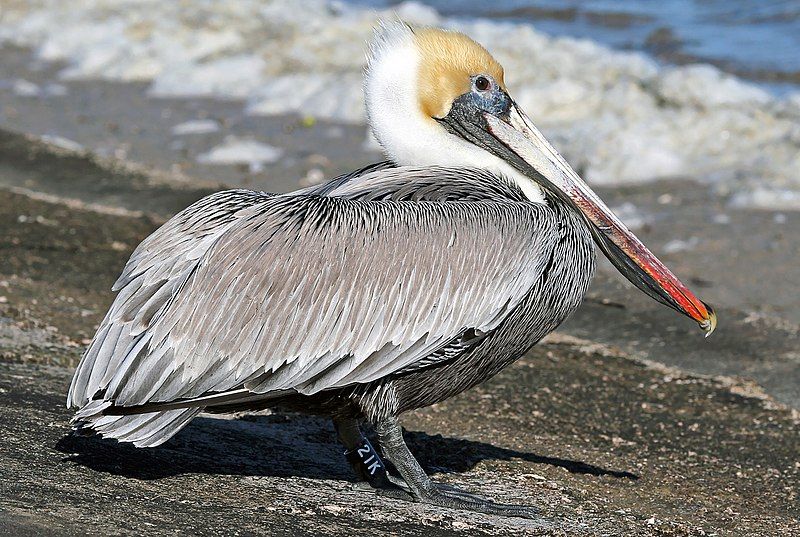
The brown pelican is a large bird that belongs to the family Pelecanidae. It is one of the three species of pelicans found in the Americas and is distinguished from other species by its unique feeding habits.
Unlike other pelicans, who usually scoop up their food from the water’s surface, the brown pelican plunges into the water to capture its prey.
This is a dangerous activity, as the bird is vulnerable to predators while in the water, but it has adapted well to this feeding strategy over the years. The brown pelican also has an impressive wingspan, reaching up to 8 feet.
This allows it to soar effortlessly above the water in search of its prey. The brown pelican is a unique species and is an integral part of the American ecosystem.
| Kingdom | Animalia |
| Phylum | Chordata |
| Class | Aves |
| Order | Pelecaniformes |
| Family | Pelecanidae |
| Genus | Pelecanus |
| Species | P. occidentalis |
4. Black Bellied Plover
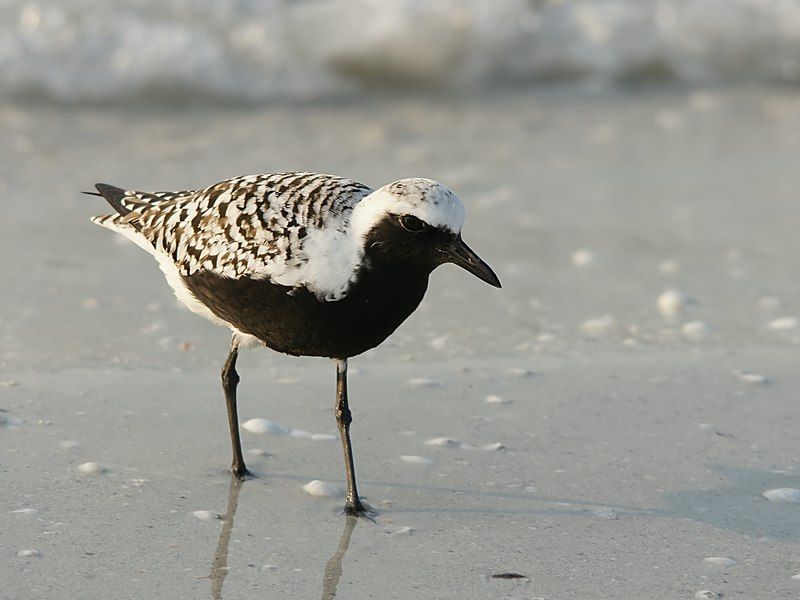
The grey plover, also known as the black-bellied plover in North America, is a sizeable cosmopolitan plover breed in Arctic regions.
It is a long-distance migrant, meaning it travels excellent distances during its life cycle and has a nearly worldwide coastal distribution when not breeding.
This means the grey plover is found on coastlines in its breeding and non-breeding areas and may also travel to other continents or oceans.
During the breeding season, grey plovers build nests on the ground in Arctic regions and may remain there for up to two months before migrating again.
In the non-breeding season, grey plovers may be found in coastal areas worldwide, including the Caribbean, Europe, and North America.
The grey plover is vital to conservation efforts, as human development and climate change often threaten its habitat.
| Kingdom | Animalia |
| Phylum | Chordata |
| Class | Aves |
| Order | Charadriiformes |
| Family | Charadriidae |
| Genus | Pluvialis |
| Species | P. squatarola |
5. Double-crested Cormorant
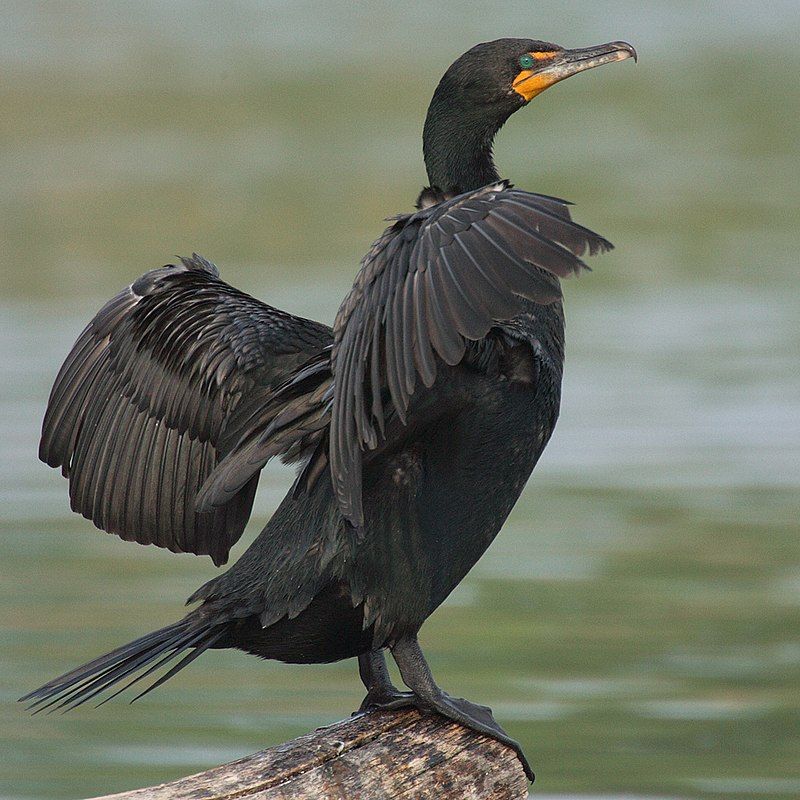
The double-crested cormorant is a water bird belonging to the cormorant family. This species is native to North America and can be found in various habitats, including rivers, lakes, and coastal areas.
Its vast range stretches from the Aleutian Islands in Alaska to Florida and Mexico. This species is incredibly adaptable and can thrive in various climates and conditions.
Its diet consists mainly of fish, although it occasionally eats amphibians, crustaceans, and other types of aquatic life.
The double-crested cormorant is an important species as it helps maintain the balance of aquatic ecosystems and provides valuable resources for anglers and hunters.
| Kingdom | Animalia |
| Phylum | Chordata |
| Class | Aves |
| Order | Suliformes |
| Family | Phalacrocoracidae |
| Genus | Nannopterum |
| Species | N. auritum |
6. Willet
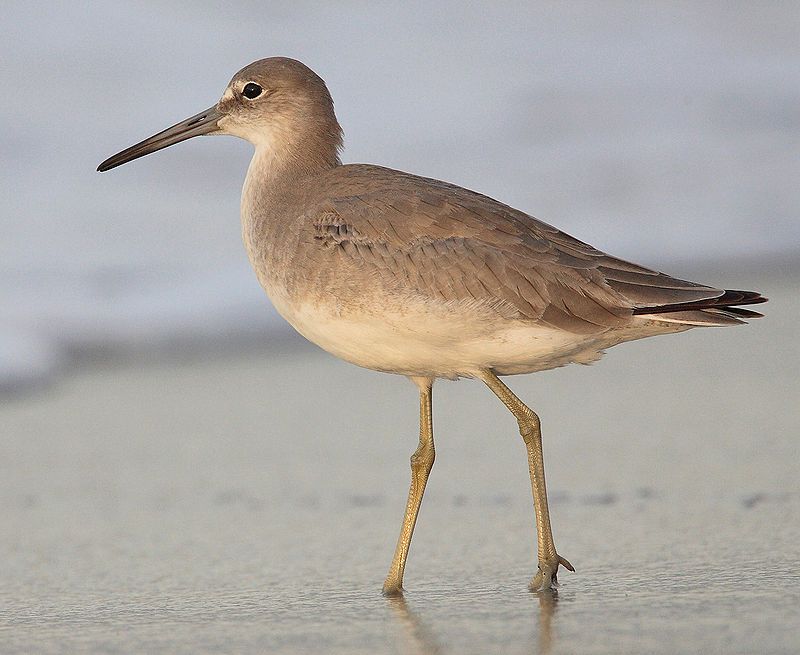
The Willet is a large shorebird that belongs to the Scolopacidae family. It is a relatively hefty sandpiper and is the largest of all the species in the Tringa genus. It is easily identifiable by its large size, robust build, and long legs.
The Willet has a brownish-gray back and wings with white or pale gray undersides. Its head is brown, with a white supercilium and dark eyeliner. The Willet is active during the day and forages in shallow waters or along the shoreline.
It feeds on crustaceans, insects, and mollusks. It can be found in coastal parts of North America and Mexico, Central America, and South America during the summer breeding season. It is a very graceful flier, capable of soaring for long periods.
During migration, it stops in wetlands and other habitats for rest and refueling. The Willet is a valuable part of the ecosystem, helping to keep insect and water-based pest populations in check.
| Kingdom | Animalia |
| Phylum | Chordata |
| Class | Aves |
| Order | Charadriiformes |
| Family | Scolopacidae |
| Genus | Tringa |
| Species | T. semipalmata |
7. American Avocet
The American Avocet is a species of wading bird found in North America and is a part of the avocet and stilt family, Recurvirostridae. This species is more significant than most other wading birds and is usually seen in shallow water or mud flats.
The American avocet has a unique foraging technique that involves sweeping its bill from side to side as it searches for food, such as crustaceans and insects.
This sweeping action is believed to help the avocet locate food more efficiently, and it is often seen doing this in the water or the mud.
The American Avocet is an integral part of the North American wetland ecosystem as its feeding and foraging habits help to control the populations of specific insect and crustacean species.
| Kingdom | Animalia |
| Phylum | Chordata |
| Class | Aves |
| Order | Charadriiformes |
| Family | Recurvirostridae |
| Genus | Recurvirostra |
| Species | R. americana |
8. Killdeer
The Killdeer is a large plover bird native to the Americas. It draws its name from its distinctive two-syllable call, often heard in the wild or captivity.
This bird species was first described and given its scientific name by Carl Linnaeus in the 10th edition of his Systema Naturae, published in 1758. There are three recognized subspecies of the killdeer, each with its unique characteristics.
These include the Northern Killdeer, the American Killdeer, and the Southern Killdeer. The Northern Killdeer is the most widespread subspecies and is found across the U.S., Canada, and parts of Mexico.
The American Killdeer is found in the Caribbean and Central and South America, and the Southern Killdeer in Argentina and Chile. All three subspecies are approximately the same size and weight and have similar coloration and plumage patterns.
| Kingdom | Animalia |
| Phylum | Chordata |
| Class | Aves |
| Order | Charadriiformes |
| Family | Charadriidae |
| Genus | Charadrius |
| Species | C. vociferus |
9. Snowy Plover
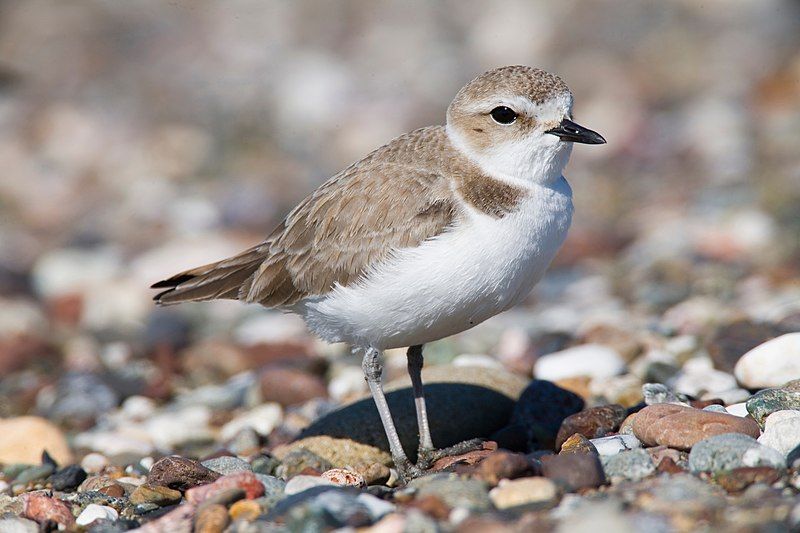
The snowy plover is a small bird belonging to the plover bird family. It typically measures between 5 and 7 inches in length, and its range extends from the southern and western United States, the Caribbean, Ecuador, Peru, and Chile.
For many years, the snowy plover was considered a subspecies of the Kentish plover; however, recent studies have revealed that it is a distinct species.
The snowy plover is an essential bird species, as it helps maintain the health of the ecosystems in its areas.
The population of the snowy plover is under threat due to habitat loss and other human activities, and conservation efforts are in place to ensure that the species can continue to survive.
| Kingdom | Animalia |
| Phylum | Chordata |
| Class | Aves |
| Order | Charadriiformes |
| Family | Charadriidae |
| Genus | Charadrius |
| Species | C. nivosus |
10. Semipalmated Plover
The Semipalmated Plover is a small shorebird belonging to the family of Charadriidae. The species’ name originates from the Late Latin word “Charadrius,” which was mentioned in the fourth-century Vulgate.
This word derives from the Ancient Greek term “kharadrios,” which referred to a bird that inhabited ravines and river valleys.
The specific epithet “semipalmated” is Latin and is derived from the words “semi,” meaning “half,” and “Palma,” meaning “palm,” about the bird’s unique half-webbed feet.
This species is an essential indicator of environmental health, as they are susceptible to changes in their habitat. As such, they are a critical species to monitor, as their presence or absence can help us better understand the health of our planet’s ecosystems.
| Kingdom | Animalia |
| Phylum | Chordata |
| Class | Aves |
| Order | Charadriiformes |
| Family | Charadriidae |
| Genus | Charadrius |
| Species | C. semipalmatus |
11. American White Pelican
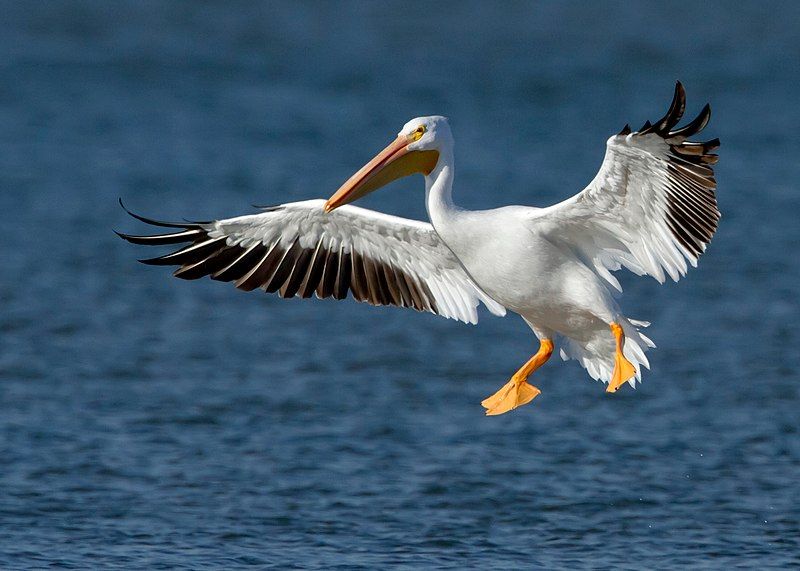
The American white pelican is an impressive bird belonging to Pelecaniformes. It is a large aquatic bird known for its powerful, soaring flight.
During the breeding season, these birds inhabit interior North American regions, including the Great Lakes, the Prairies, and the Mississippi Valley.
Once the breeding season ends, the white pelican will migrate south to the coasts of many countries, including Costa Rica, for the winter.
This pelican species is unique in its wide-ranging migration, as many other species of pelicans are known to stay in much more localized areas.
The American white pelican is a beautiful bird to behold, and its impressive migratory patterns make it an exciting creature to study.
| Kingdom | Animalia |
| Phylum | Chordata |
| Class | Aves |
| Order | Pelecaniformes |
| Family | Pelecanidae |
| Genus | Pelecanus |
| Species | P. erythrorhynchos |
12. Dunlin
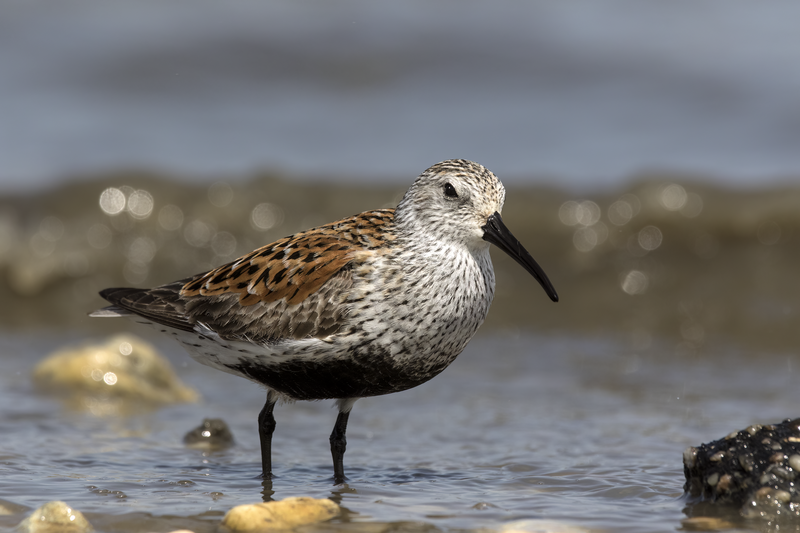
The dunlin is a small wader bird belonging to the same family as other wading birds, such as stints. The bird’s name originates from the term “dunling,” first documented in 1531-1532.
The term is derived from the word “dun,” which is a term used to describe dull brown coloration. The suffix “-ling” suggests the bird has this dull brown coloring. The dunlin is generally found in coastal habitats, where it spends time foraging for food on the ground.
It is a migratory bird and travels worldwide for its preferred food sources. In the winter, they congregate in large flocks in areas such as the Great Lakes, and in the summer, they move to the wetlands of northern Europe and North America.
The dunlin is a unique species, as it is the only member of the genus Erolia that is placed in its own family. It is a relatively small bird, measuring approximately 18 cm in length. It has a black and white striped back and a white belly.
Its bill is short and pointed, and its legs are grey. The dunlin is an important species to be aware of, as its population is declining due to human interference and the destruction of its habitats.
It is currently listed as a vulnerable species by the IUCN Red List, and its conservation is paramount.
| Kingdom | Animalia |
| Phylum | Chordata |
| Class | Aves |
| Order | Charadriiformes |
| Family | Scolopacidae |
| Genus | Calidris |
| Species | C. alpina |
13. Snowy Egret
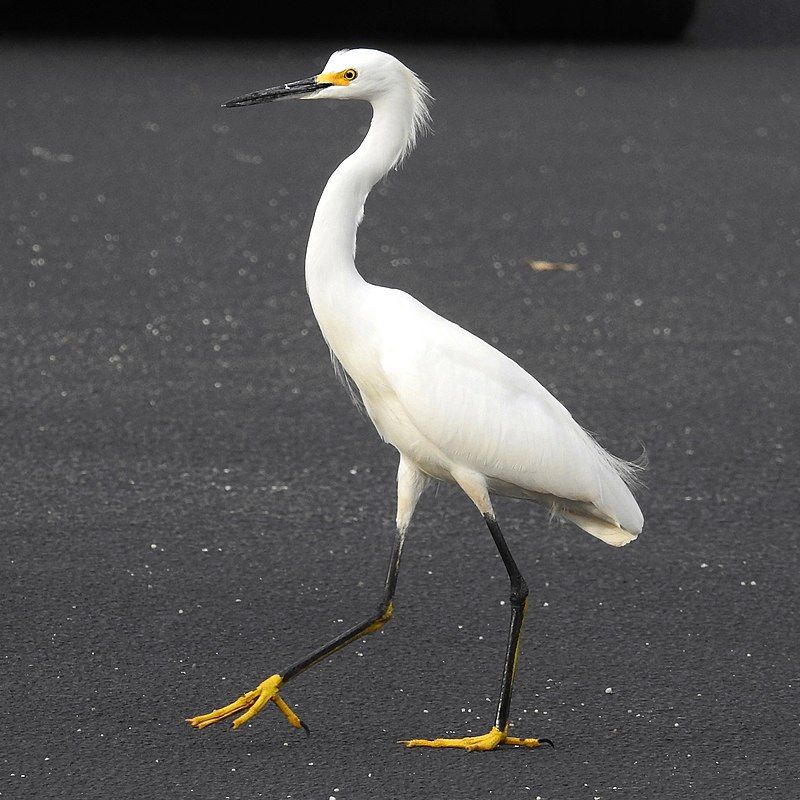
The snowy egret is a small white heron that is native to many regions around the world. Its scientific name comes from Provençal French, aigrette, which means “little egret.” This was then changed to Saigon, meaning “heron” in French.
The species name, thula, is an Araucano term for the black-necked swan. This was mistakenly applied to the snowy egret by Chilean naturalist Juan Ignacio Molina in 1782. The snowy egret has white plumage and a black bill.
The legs and feet are yellow, and the eyes are yellow-orange. Its wingspan can reach up to 40 inches (100 cm) and weigh up to 7 ounces (200 g). Its habitat includes marshes, swamps, coastal areas, and lagoons.
It can be found in North and South America, Europe, Asia, and Africa. The snowy egret feeds mainly on small fish, crustaceans, and aquatic insects. It typically hunts by wading in shallow water and using its bill to snatch up prey.
It also uses a technique called “dipping, ” which flaps its wings to stir up prey. It is a solitary bird but may form large flocks during breeding.
The snowy egret is an important species for conservation and is protected by the Migratory Bird Treaty Act in the US. It is a species of “least concern” on the IUCN Red List, meaning it is not threatened with extinction.
It is an essential symbol of conservation, as it was once hunted for its plumes to decorate hats and clothing. The snowy egret is a beautiful species that can be enjoyed in its natural habitat.
| Kingdom | Animalia |
| Phylum | Chordata |
| Class | Aves |
| Order | Pelecaniformes |
| Family | Ardeidae |
| Genus | Egretta |
| Species | E. thula |
14. Short-billed Dowitcher
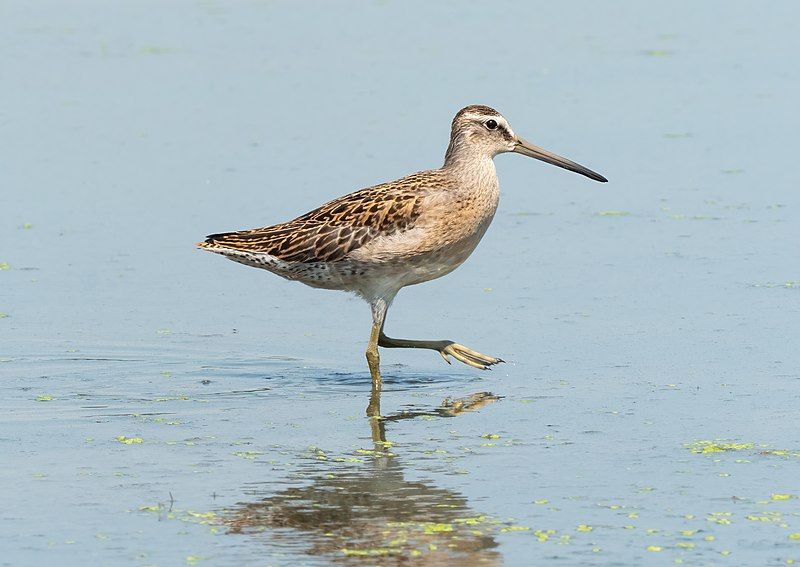
The short-billed dowitcher is a species of shorebird found in various parts of North America, Central America, the Caribbean, and northern South America.
It is a member of the family Scolopacidae, which also includes the long-billed dowitcher, and is a medium-sized, stocky bird with a long bill.
This species is quite distinct from the long-billed dowitcher, although the two have some physical similarities. The short-billed dowitcher is typically grey-brown, with a pattern of dark and light spots used for camouflage.
Its long bill is curved downwards and has a unique pattern of stripes running along its length. The bill is shorter than the long-billed dowitcher, which helps distinguish the two species.
Its body is somewhat stocky, with short legs and a slightly rounded tail. The short-billed dowitcher has many habitat preferences and can be found in damp grasslands, marshes, beaches, mudflats, and other shallow water areas.
It feeds mainly on aquatic insects, small crustaceans, and mollusks, which it finds while probing the muddy bottoms of these shallow water habitats.
This species is usually seen in small flocks and can be spotted flying low over the water or foraging on the ground. The short-billed dowitcher is an integral part of the ecosystem, helping to control insect and crustacean populations and providing food for various other animals.
It is also an essential part of the North American bird-watching community, as it can be easily identified and is a common sight in many parts of the continent.
| Kingdom | Animalia |
| Phylum | Chordata |
| Class | Aves |
| Order | Charadriiformes |
| Family | Scolopacidae |
| Genus | Limnodromus |
| Species | L. griseus |
15. Spotted Sandpiper
The spotted sandpiper is a small shorebird belonging to the genus Actitis and its sister species, the common sandpiper.
These two species live in different geographical regions, but they may come together and hybridize when a stray bird from one species settles down and breeds with members of the other species.
Hybridization happens when two genetically similar but distinct species mate and produce offspring with a combination of both species’ traits. Hybridization can occur either naturally or as a result of human intervention.
Hybridization can have both positive and negative effects on the species involved. Positive effects include increased genetic diversity and adaptability, while adverse effects include reduced fitness and reproductive isolation.
| Kingdom | Animalia |
| Phylum | Chordata |
| Class | Aves |
| Order | Charadriiformes |
| Family | Scolopacidae |
| Genus | Actitis |
| Species | A. macularius |
16. Black-crowned Night Heron
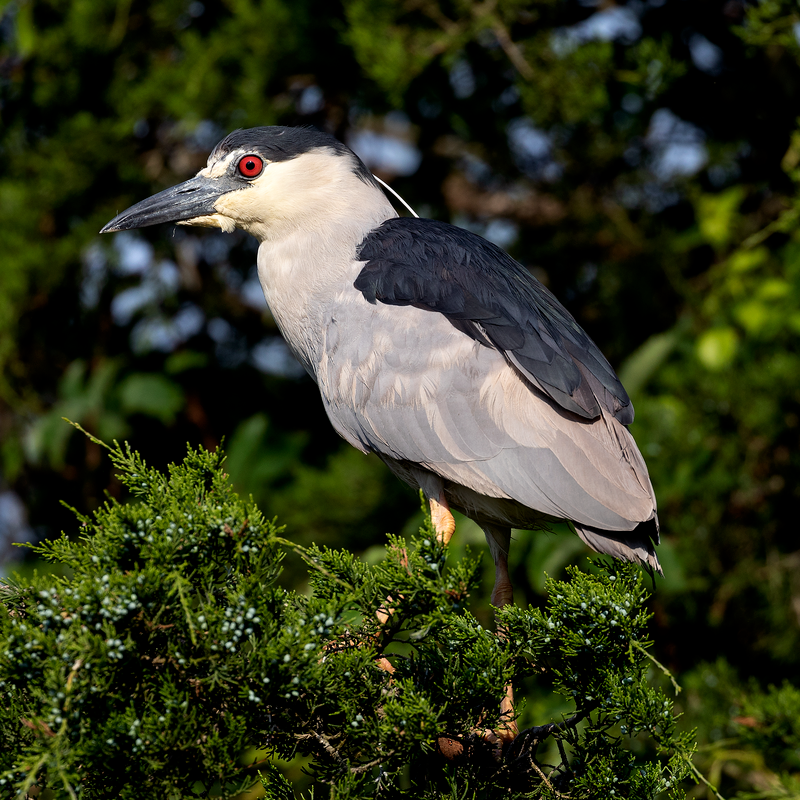
The black-crowned night heron, also known as the black-capped night heron, is a medium-sized bird found worldwide. It is sometimes referred to simply as the night heron in Eurasia.
This heron is native to parts of Europe, Asia, North America, and South America. Its plumage is primarily dark grey or black, with a black crown on its head and white spots on its wings and tail. Its neck is short and thick, and its bill is dense and slightly hooked.
Its legs are short and stout, and its feet are yellow. It has an impressive wingspan that can reach up to 1.5 meters. The black-crowned night heron is an opportunistic feeder, which means it will take advantage of any available food.
It primarily eats small fish, frogs, crustaceans, and insects. It is a solitary bird usually seen in wetlands or near bodies of water. It is also known to roost in trees during the day.
The black-crowned night heron is a widespread species with a global population estimated at over one million individuals.
It is not considered threatened or endangered at this time, although its numbers are declining in some parts of its range due to habitat loss and other human-related threats.
| Kingdom | Animalia |
| Phylum | Chordata |
| Class | Aves |
| Order | Pelecaniformes |
| Family | Ardeidae |
| Genus | Nycticorax |
| Species | N. nycticorax |
17. Mallard
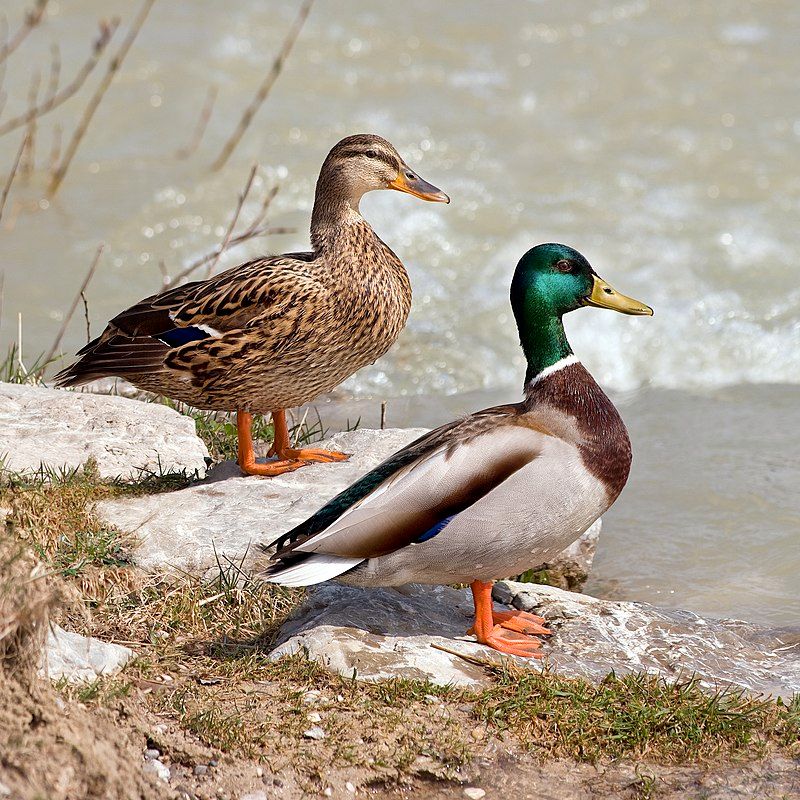
The mallard or wild duck is a species of dabbling duck widely distributed across North America, Eurasia, and North Africa. It is a migratory bird, breeding in temperate and subtropical climates in these regions.
The mallard is a species that has successfully been introduced to other regions of the world. It has been introduced to New Zealand, Australia, Peru, Brazil, Uruguay, Argentina, Chile, Colombia, the Falkland Islands, and South Africa.
The mallard is a widely recognized species with a distinctive green head and yellow bill. It is a common sight in parks, wetlands, and other areas where it can find suitable habitat.
As a dabbling duck, the mallard feeds primarily on plants, such as aquatic vegetation, grains, and seeds. It is an adaptable species, able to thrive in various habitats, including urban parks and gardens. The mallard population is considered to be stable in most areas.
However, habitat loss and other human activities, such as hunting, threaten the species. Conservation efforts, such as habitat protection, are necessary to ensure the species’ long-term survival.
Research into the species’ ecology and behavior can help us better understand the mallard and other bird species.
| Kingdom | Animalia |
| Phylum | Chordata |
| Class | Aves |
| Order | Anseriformes |
| Family | Anatidae |
| Genus | Anas |
| Species | A. platyrhynchos |
18. Red knot
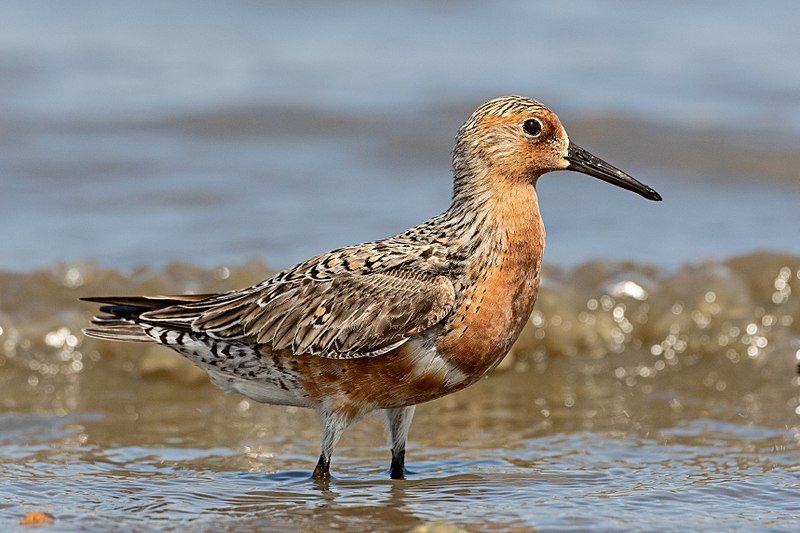
The Red Knot (Calidris canutus) is a medium-sized shorebird widely distributed across Canada, Europe, and Russia. It is a member of the Calidris sandpiper family, the second-largest bird family in the world.
The Red Knot is found in tundra and the Arctic Cordillera in the far north of these countries. It is the second most prominent member of the Calidris sandpiper family, only surpassed by the Great Knot.
The Red Knot is a medium-sized bird with a length of about 21-28 cm and a wingspan of about 46-51 cm. Its plumage is mainly grey, with reddish-brown markings on the head, breast, and wings.
Six subspecies of the Red Knot are recognized based on size, habitat, and plumage differences. The American Red Knot is the most commonly found subspecies, and it is found mainly in North America.
The Eurasian Red Knot is in Eurasia, while the Pacific Red Knot is in the Pacific Rim. The other three subspecies are found in Africa, Asia, and Australia. The Red Knot is an important species for its ecological role in the environment.
It feeds on various invertebrates, including mollusks, crustaceans, worms, and insects. It is an essential source of food for other birds and predators and an important species for shoreline conservation.
The Red Knot is a migratory bird with one of the longest migration routes of any bird. It migrates from its breeding grounds in the far north to its wintering grounds in the southern hemisphere.
During its migration, the Red Knot can travel up to 15,000 km, making it one of the longest-distance migrants of any bird. The Red Knot is an important species for conservation, and it is listed as ‘Near Threatened’ by the IUCN.
It is threatened by habitat loss, hunting, and pollution. Conservation efforts have focused on protecting its habitat and migration routes and banning the hunting of the species.
| Kingdom | Animalia |
| Phylum | Chordata |
| Class | Aves |
| Order | Charadriiformes |
| Family | Scolopacidae |
| Genus | Calidris |
| Species | C. canutus |
19. Marbled Godwit
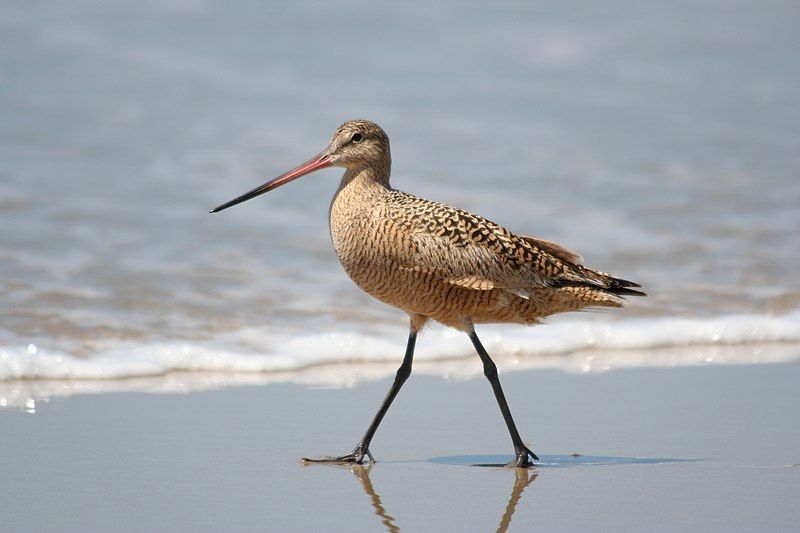
The marbled godwit is a large shorebird belonging to the Scolopacidae family. It is a migratory species, traveling long distances between its breeding and wintering grounds.
It is the largest of the four godwit species, with an average body length of 33 to 38 cm and a 69 to 75 cm wingspan. They have a long, slender bill adapted to probe for invertebrates in the muddy shorelines of their wetland habitats.
The plumage of the marbled godwit is mostly brownish and grayish, with light barring on the wings and tail. During the breeding season, the male marbled godwit has a distinctive pink-and-black barred head and neck. The female’s plumage is mottled and less brightly colored.
It is an essential member of many wetland ecosystems, providing food for predators such as gulls, hawks, and owls and serving as a host species for parasites and other invertebrates.
It is also vital to many food webs, as it feeds on invertebrates like insects, worms, mollusks, and crustaceans. The marbled godwit is a species of conservation concern due to its declining population caused by habitat loss, degradation, and climate change.
Conservation efforts are underway to help reverse this trend and protect the species from further decline.
| Kingdom | Animalia |
| Phylum | Chordata |
| Class | Aves |
| Order | Charadriiformes |
| Family | Scolopacidae |
| Genus | Limosa |
| Species | L. fedoa |
20. Red-tailed Hawk
The red-tailed hawk is a captivating bird of prey widely distributed throughout North America. It can be found from the interior of Alaska and northern Canada down to Panama and the West Indies.
This bird is classified as a member of the Buteo genus and is one of the most common birds within this genus in North America or anywhere else in the world. Red-tailed hawks are typically recognized by their reddish-brown tails and wings.
They have a large wingspan and are known to be quite strong fliers, capable of traveling considerable distances for food. They feed on small mammals, and birds often perch on high branches or poles, waiting for unsuspecting prey to pass by.
They also build nests in trees and can often be seen soaring through the sky, searching for prey, or trying to spot potential threats. The red-tailed hawk is an integral part of the North American ecosystem, as it helps to keep small mammal and bird populations in check.
They are also a source of beauty and inspiration for many birdwatchers and nature enthusiasts and can provide hours of entertainment as they soar through the sky.
| Kingdom | Animalia |
| Phylum | Chordata |
| Class | Aves |
| Order | Accipitriformes |
| Family | Accipitridae |
| Genus | Buteo |
| Species | B. jamaicensis |
21. Anna’s Hummingbird
Anna’s hummingbird is a species of hummingbird that is native to North America. It is named after Anna Masséna, Duchess of Rivoli, and is found in western coastal regions from northern Baja California to Southern California.
In the early 20th century, Anna’s hummingbirds were mainly found in these two regions, although their range has since expanded. They prefer to inhabit areas with plenty of flowering shrubs and trees that provide them with nectar.
They are small birds with iridescent feathers, and their short, high-pitched calls can often be heard in the early morning and late afternoon. They are also known to be fiercely territorial and will aggressively chase away any other birds that enter their territory.
| Kingdom | Animalia |
| Phylum | Chordata |
| Class | Aves |
| Clade | Strisores |
| Order | Apodiformes |
| Family | Trochilidae |
| Genus | Calypte |
| Species | C. anna |
22. Bald Eagle
The bald eagle is a majestic bird of prey native to North America. It is a large bird with a wingspan of up to 7.5 feet and is easily recognizable by its white head, tail, and dark brown body.
Its two subspecies are the North American bald eagle and the Steller’s sea eagle, found in parts of Asia. The bald eagle is a sea eagle, meaning it prefers to inhabit coastal areas and feed on fish and other aquatic animals.
It is closely related to the white-tailed eagle, which lives in the Palearctic region of Eurasia and has a similar diet and lifestyle. This species pair share the same ecological niche in the wild and can often be found near each other in their natural habitats.
The bald eagle is an essential symbol of the United States and is often used as a national emblem. It is considered a conservation success story, as its population has increased significantly since it was placed on the endangered species list in the 1960s.
Today, bald eagles can be spotted in many parts of North America, soaring through the skies and searching for prey.
| Kingdom | Animalia |
| Phylum | Chordata |
| Class | Aves |
| Order | Accipitriformes |
| Family | Accipitridae |
| Genus | Haliaeetus |
| Species | H. leucocephalus |
23. Green Heron
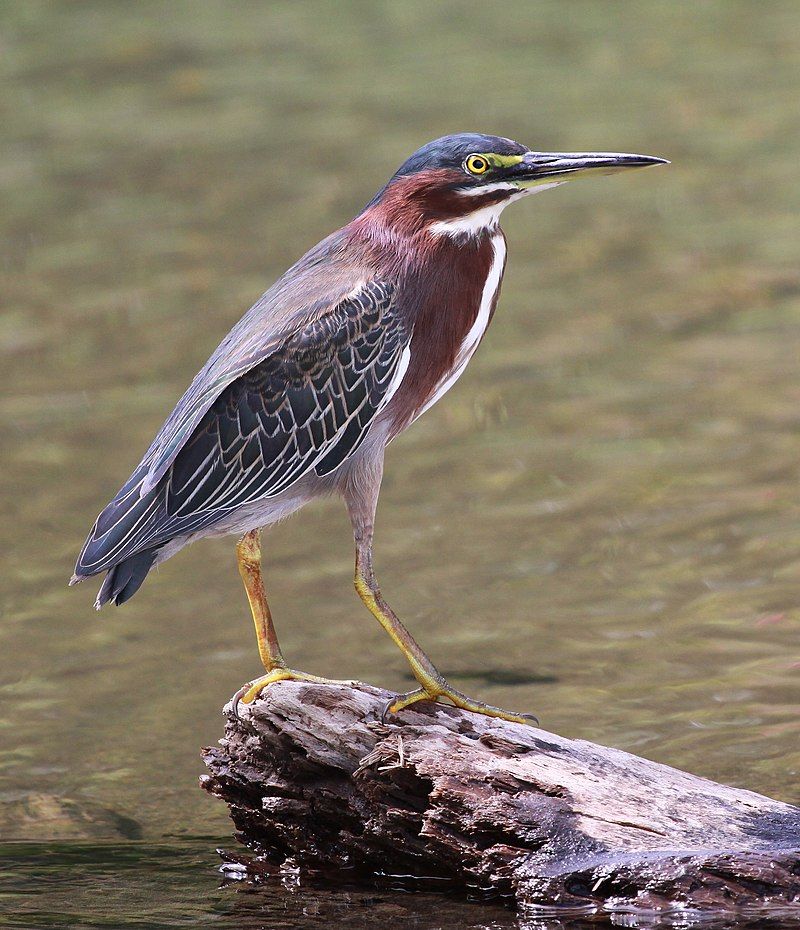
The green heron is a small species native to North and Central America. Its scientific name is Butorides virescens, derived from Middle English and Ancient Greek.
The term “butor” is derived from Middle English and refers to a type of bittern, while the suffix “-oides” is from Ancient Greek and refers to something that resembles something else.
The word “virescens” is Latin for “greenish,” which aptly describes the bird’s coloration. The green heron is a reasonably small species, typically measuring 25 and 35 cm long.
Its plumage is predominantly greenish-black and has a pale chest and neck. Its long legs are yellowish-green, and its bill is black. This species is widespread and can be found near calm bodies of water such as ponds, marshes, and lakes.
The green heron is a solitary species generally seen alone or in pairs. During the breeding season, however, they may form large colonies. They have various vocalizations, including croaks, grunts, and squawks.
Its diet consists mainly of fish, crustaceans, amphibians, insects, and small mammals. The green heron is a unique and fascinating species well-known for its fishing technique.
Rather than using its bill to catch prey, this species will often drop a feather, twig, or leaf onto the water’s surface to lure unsuspecting prey closer. The green heron quickly snatches it up with its bill when the prey is close enough.
The green heron is an exciting species native to North and Central America. Its scientific name is derived from Middle English and Ancient Greek, and its Latin name means “greenish.” This species is relatively small and is typically seen alone or in pairs.
It has a wide variety of vocalizations, and its diet consists mainly of fish, crustaceans, amphibians, insects, and small mammals. Additionally, the green heron is known for its unique fishing technique.
| Kingdom | Animalia |
| Phylum | Chordata |
| Class | Aves |
| Order | Pelecaniformes |
| Family | Ardeidae |
| Genus | Butorides |
| Species | B. virescens |
24. Western Sandpiper
The western sandpiper is a small shorebird belonging to the genus Calidris, derived from the Ancient Greek term kalidris or skalidris. Aristotle used this term to describe certain grey-colored waterside birds.
The specific mauri of the western sandpiper commemorates Italian botanist Ernesto Mauri. This is a fitting tribute to the botanist, as the sandpiper is a species found on the shoreline.
Ernesto Mauri was a renowned botanist who significantly contributed to studying plants and their habitats.
The western sandpiper is a small bird typically found on the shoreline, and its generic and specific names pay homage to botanist Ernesto Mauri’s significant contributions.
| Kingdom | Animalia |
| Phylum | Chordata |
| Class | Aves |
| Order | Charadriiformes |
| Family | Scolopacidae |
| Genus | Calidris |
| Species | C. mauri |
Conclusion
Birds in Long Beach are an essential part of the local ecosystem and provide a great way to enjoy the outdoors. With various habitats and bird species, Long Beach is an ideal place to observe and appreciate birds.
Whether walking along the beach, visiting a local park, or simply sitting and watching from your window, bird-watching can be fun and rewarding.
With so many options for bird watching in Long Beach, it is easy to appreciate the beauty and diversity of the local avian population.